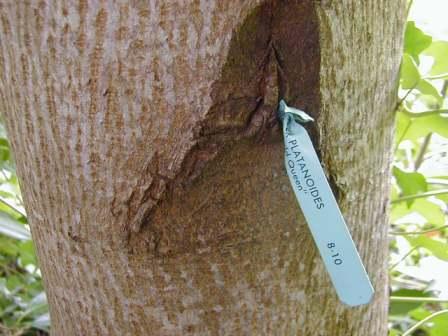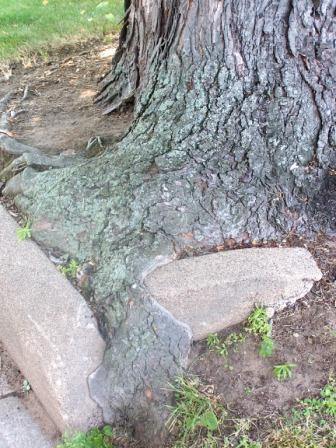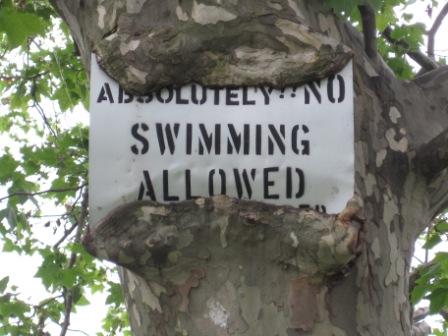I’ve been suffering through my post-holiday, post-annual-reporting cold and/or flu, so I don’t feel as witty (or snarky) as I might otherwise be. Instead, I feel like my body’s been invaded by a slowly spreading mass that reminds me…oh, I don’t know…of what trees can do when they encounter an immovable object.
Not much of a segue, I know, but I just had the urge to post some interesting photos after Holly’s photo-fest yesterday. (Memo to self: not fun being Holly’s follow-up act.) Anyway, you’ve seen what happens when growing trees encounter neglected plant tags:

And perhaps you’ve seen how roots laugh at puny planting pits:

So before you feel the urge to attach something – anything – “permanently” to a tree, keep in mind that they have no respect for authority…

…or even those who got them started in life:

Great post, especially for a “post-holiday, post-annual-reporting cold and/or flu” post. And impressive photos too even if you failed to include some of Tolkien’s Ents or at least one depicting the Whomping Willow in order to meet the claims of the post’s scary title. 😉
On a more serious note, I wonder why the tree (plane tree?) tried to swallow the “no swimming” sign in the first place. Did they cut in the trunk when mounting the sign?
I thought about swiping some tree images…but didn’t want to bring the even scarier copyright police down on my head. It does look like the trunk was shaved where the sign was attached, though I don’t know for sure (Buffalo readers can check it out – it’s at Delaware Park lake.)
Hahahaha! CHOMP! Someone needs to glue googly eyes above that No Swimming sign!
Love the photos. They make a couple of great points sans words.
People putting things on trees is one of my pet peeves! I have seen what happens when a saw hits a nail or a frying pan that was carelessly left in the fork of a tree. Why do people not realize the damage they can do?
Question: Do you think that Juniper trees are invasive?
LynnBay: I posted on Holly’s comments but will re-post here regarding invasiveness of junipers: Eastern redcedar (Juniperus virginiana) is considered invasive in prairie ecosystems. Birds have undoubtedly always dropped seeds onto grasslands from adjacent woodlands, but suppression has increased encroachment of redcedars.
Maybe I should print out some of these photos & tape (not nail !) them to some trees in my neighborhood. Several times under cover of darkness I’ve cut the bands holding 15-year-old trees to their 2″ ‘support’ posts simply
because the tree was being strangled. How can someone who keeps the surrounding lawn so perfect – as many of my neighbors do – be so blind to the damage they are doing to their trees ?
Laura, you’re a woman after my own heart! I’ve done the same things with a pair of wire clippers. Maybe my next posting will be the “neglected staking chamber of horrors.”
Love the stalkers…. Peple who keep perfect lawns think that posts and wire are what is expected in a good landscape. Lawnies is a differnt breed altogether. …..Eastern red cedar is quite agressive in the Valley. We foresters look at it as one of our native pioneer tree species. Periodic native American burnings probably kept it in check in the native prarrie-like ecosystem thst once occupied this part of Virginia. …. Oh BTW, gotta love the tenacity of trees.
Johannes – I don’t think they had to cut into the trunk, necessarily. The town nailed a No Parking sign to a maple on the street I grew up on, and I’ve watched the tree actually grow around and swallow the sign – even though one would logically assume that the tree would simply push against the sign from behind and eventually cause the nailheads to fail. Clearly the message is “don’t mess with nature.”
My arboriculture lecturer always described the concept of tree growth as: every year, a new tree grows over the old wood. I think these photographs reflect that concept beautifully.